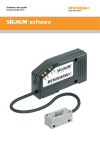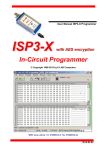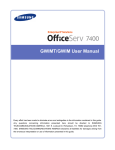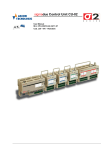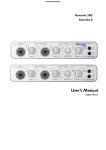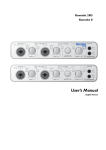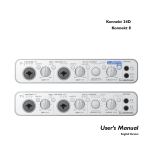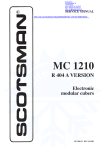Download AVR ICP-V24/USB Portable
Transcript
Manual AVR ICP-V24/USB Programmer AVR ICP-V24/USB Portable © Copyright 1998-2002 by E-LAB Computers WEB: www.e-lab.de Tel: 07268/9124-0 Fax: 07268/9124-24 E-LAB Computers AVR ICP-V24/USB portable Programmer Overview In-Circuit Programming (ISP or JTAG) is the technology of the future at least for small and medium series of electronic components with embedded processors. At least with SMD parts there is the problem of programming because many expensive and specialized adapters are required. An additional advantage of ISP/JTAG in conjunction with the AVR is the practically unlimited reprogrammability of the CPU’s . This ISP-Programmer emphasizes by minimum size, extensive software and the possibility of remote control. This manual is only valid for the ICP-V24 and ICP-USB and with restriction for the formerly ICP-V24 versions of programmers. Features • Connection to the PC through a serial port (COM1..COM8) (Option USB) • ACCU operation of the device with charge unit. Overcharge and overload protected • No powersupply necessary. The unit is powered direct from the serial port of the PC, the ACCU or the target. Standby 40uA • Adapts automatical to the targets voltage (2.7-6Volt ca. 17mA) • Easy and extensive software • Software runs under Win98/2000/NT/XP • USB versions are restricted to Win2000 and XP • Remote programmer start • Small, light weight and handy unit 130x70x25mm • New CPU-types are configurable by the user through ascii text files • Hexfiles are loaded from PC into the programmer and stored in the ACCU powered SRAM • CPU type, fusebits etc are selected from the Host/PC. • Programmer can be moved from target to target w/o PC connection or interaction. • Password protection of the programmer • Programmable supply voltage (source) for the target system 2.7..5.2Volt 30mA/100mA • Self update feature via the PC • Supports JTAG and SPI programming • Supports also JTAG Boundary Scan of the target system • Supports also the whole AT89Sxx family • Useable as volume production programmer 2 • User Manual AVR ICP-V24/USB portable Programmer 27.05.2003 E-LAB Computers AVR ICP-V24/USB portable Programmer Connections Windows-98/2000/NT or XP is required. For USB versions only Win2000 and XP can be used. V24 Version The E-LAB programmer must be plugged to any serial interface (COM1 – COM8) of the PC. The 9-pin plug must be completely connected. A simple wiring of RxD, TxD and GND is not allowed. Pin7/RTS and Pin4/DTR serve as a powersupply and for ACCU chargeing. In addition DTR generates a Hardware Reset, when it changed from –10Volt to +10Volt. USB Version The included USB cable must be connected to a free USB connector of the PC. The USB drivers must be installed one time in order to work properly. See the USB section at the end of this manual. The programmer is supplied with power by an internal 3.6Volt ACCU. The ACCU is charged either by the serial PC-interface, the target if connected, or the included external powersupply. The charge time from empty to full is max. 12 hours. The ACCU-voltage is monitored, so an overcharging or a deep discharge is nearly impossible. The internal voltage is 3.3Volt. If the voltage of the target exceeds 3.6Volt the supply of the target is used automatically. Don’t apply high loads at the target pins used for programing. No capcitors are allowed at these pins. At the reset pin a C/R with max. 100nF/1kOhm is allowed. Lower impedances must be avoided. The definition of the 6-pin SPI target plug (0.1 inch pitch male header, dual inline) conforms to a recommendation from Atmel. The TOP VIEW onto the connector of the Target is below: CPU MISO(TxD) o1 2o VCC CPU SCLK o3 4o CPU MOSI(RxD) o5 6o GND /RES Attention! The /PEN pin of the mega64/103/128 has to be connected to VCC. These megas use TxD+RxD+SCLK for programming!! TopView SPI header Pin1 of the 6pin plug of the programmer can be located by a small triangle on the front of it. A missalignment of the plug leads to malfunction and can possibly DESTROY the unit. The working voltage of the Target CPU must be in the range of 2.7V..5.5V. None of the control lines of the device must be shortened. A continous short circuit can destroy the programmer permamently. Only electrical tested and working boards should be connected. JTAG programming For JTAG programming of the target CPU the 6-wire ribbon cable must be replaced by 10-wire type. Because the ICP uses the same plug for ISP and also for JTAG programming the JTAG plug on the target system differs from the original Atmel JTAG plug. See the schematic on the left. On the left is the recommended E-LAB plug connection which must be used for the target system if the JTAG interface of the target AVR must be used for programming. Please note that the /RESET line is also needed for JTAG. 27.05.2003 User Manual AVR ICP-V24/USB portable Programmer • 3 E-LAB Computers AVR ICP-V24/USB portable Programmer Programming Attention: Before the first operation of the unit please charge the ACCU several hours with the included power supply. Please read the paragraph ACCU-charging! The device has two buttons, prog/continue and era/clear. prog button If both LEDs of the ICP are dark, the device is in powerdown state. It can be wakened by a click to the PROG button or by connecting it to the PC and start the PC-program AVRprog.exe The device now processes a memory test and an ACCU check. The ACCU check measures the ACCU voltage. If it is too low, i.e. the ACCU is empty, the two LEDs are flashed once one after another. Then the device immediately gets in it’s power down state. Then it is very important to plug the included ACCU charge supply to the device. The memory test builds some checksums and compares them with others stored in the memory. If an error occurs so both LEDs are flashed synchronously on/off. The device now expects a correct new download of a project from the PC. If the also the memory check was ok, both LEDs are alternated cyclically (left/right) and the device is in it’s basic state. Pressing the prog now starts a programmiing cycle. If the target (CPU) is connected and is powered like expected, the prog-LED flashes until the process has finished or an error occured. If the programmiing was successful the device enters it’s basic state which is showed by an alternate flashing of the two LEDs. If an error appeared (error code on the left LED) this error must be cleared by the era/clear button and the device again enters it’s idle state. In case of an error there are two special cases: 1. A wrong device-ID was read out of the target CPU (2xflash). Because this ID is stored in EEprom cells in the AVR CPU and this content can be lost under some circumstances this error (wrong ID) can be ignored and the programming can be continued by an additional click to the prog/continue button. 2. If the project setup expects that the target system must be powered by the programmer itself and the error „Target Power Down“ (1xflash) appears, this error can only be removed if the charging supply is connected to the programmer and the target then is supplied by the programmer. Furthermore (in this case) the target voltage is checked for the expected value. A voltage deviation of more then +/-0.2Volt also results in an error. era button This button mainly serves to quit an error condition like described above. Secondly a complete chip erase can be done with the target CPU. While erase or programming there can be several errors, which are displayed by a count of flashes of the left LED whilst the right LED is continously on: 1x flash = Device Power down 2x flash = Wrong device/signature (especially with 90S1200) 3x flash = Device protected 4x flash = Device not empty 5x flash = Verify error 4 • User Manual AVR ICP-V24/USB portable Programmer 27.05.2003 E-LAB Computers AVR ICP-V24/USB portable Programmer Stand-alone The programmer can be invoked from the Compiler’s IDE (PED32) and also stand-alone by it’s EXE name. Calling it from the IDE automatically several application parameters (CPU-Type, Clock, Hex-file etc.) are passed to the programmer. With Stand-alone (direct call of the EXE by the user) the Project select dialog is opened. A project can be opened and loaded by a double click onto the desired entry or by a single click onto the entry and an additional click onto the Load-Button. All project related parameters and files are loaded, so one can start with a download or the programming. Display of the project in the PC Details of the highlighted project from the select window with CPUtype. Accompanying project path. The Flash Hexfile with file extension. EEprom file with extension Store changed or new project. Commands Build a new project Delete a project Edit an existing project Load a project Search project on network Exit this dialog. Build a new project: Click button New. Type the desired name into the fieldProject Name. Click to the field Directory. From the appearing dialog select the desired directory. Now the dialog for selecting the file extensions and file types appears. Select/edit extensions and file types. The Flasf file dialog appears. Select the file which contains the Flash contents. Up to here the selections etc. are a must. The following dialog for selecting an EEprom file can be ignored, if nothing exists. At last the CPU type must be selected from the CPU-Select dialog. The new project must be stored by the Save button. Editing an existing project: Click the button Edit. The program is now in edit mode. With a click onto the items and fields the accompnying dialog is opens. After all changes are done, store them with a click onto the Save button. Dialog for the file types and extensions of a project. These parameters are project related und must be defined for each new project. Edit of an existing project: click Button Edit. By a click to any edit field a dialog opens. After changing of the project’s properties the project must be stored with the Save button. 27.05.2003 User Manual AVR ICP-V24/USB portable Programmer • 5 E-LAB Computers AVR ICP-V24/USB portable Programmer Comment Editor A right click to an entry in the project select/load dialog opens this Comment dialog. With this dialog it’s possible to add or view a comment for each project. Dialog for CPU selection Device state dialog After selecting the CPU the clock-frequency of the target must be set. To do this, the button opens the Device State Dialog. The dialog shows the parameters of the PC-loaded project resp. the parameters of the hex-files loaded. The parameters and the corresponding hex-files must be transfered into the ICP-programmer by clicking the Download-button in order to be valid in the programmer. Editable parameters are located in the Environment box. The clock defines the SPI speed for ISP programming and can be changed every time. If this value is too high, the programming can fail. For JTAG programming mode this value has no meaning. But this parameter should have always the correct value. The voltage field on the right of it reflects the current voltage value which the ICP programmer measures on the target board, if connected. The voltage defines the length of the program pulse and by that also the total programming time (except JTAG programming). The lower two fields of voltage and current are only visible if a programmer type is connected which has the feature of supplying the the target with a selectable voltage. The ICP-V24 is such a device. 6 • User Manual AVR ICP-V24/USB portable Programmer 27.05.2003 E-LAB Computers AVR ICP-V24/USB portable Programmer The current field selects the maximal allowed current to supply. 0.0mA sets the internal supply to the off state. The other values enable the ICP-internal supply. If a current > 0mA is selected the desired supply voltage can be selected in the voltage field. If enabled the ICP programmer supplies the selected voltage to the target system (only in programming state), provided that the ICP’s power supply is connected. The current will be limited to the selected value. USB version and power supply Values > 4.5Volt need an external power supply (6..10V=) which must be connected at the ICP. Values < 4.5Volt can be directly powered from the USB line. The field Application shows the actual loaded project in the PC. The field Programmer shows the information about the connected programmer device: programmer type, firmware revision and the last firmware update. The last item is important because all update files start with their date-of-build yy-mm-dd. In the picture above this is 2002, February, 26. So one can easily find out whether a new downloaded file from the WEB is the same or newer than the one already downloaded in the ICP. The download of an update into the ICP is described below. If the portable device ICP is connected to the PC, in the lower field „Download buffer“ the state of the device internal buffer is displayed. If the programmer is connected to the PC, the field Download Buffer shows the state of local buffers of the programmer. An ok means, that the local checksum is valid and because of this also the data. The item Proj: shows the project name stored in the programmer. The loaded project in the PC is identical with the programmers project, if it was downloaded by the DownLoad button. The PC-Software informs the user about differences of the PC’s project and the programmers project every time an action or command needs synchronousity of the projects. If both projects are the same, also the file date of the flash file in PC and programmer are compared. If the date in the PC is newer, so a message dialog informs the user about this. Notes Normally the following is true: All operations interact with the project which is stored in the ICP-programmer and not with the project loaded in the PC. Because of this it’s absolutely necessary after any changes with the project in the PC to start a download. Then the state in the PC is synchronized with the state of the ICP! Protection of the programmer against external short-circuits and over-voltage All newer programmer types are protected against continous short circuit. The overvoltage protection must be somewhat limited by such a device and is only allowable for a very short time and low voltages. The protection consists of a resistor-zenerdiode combination for each control line. The resistor is a 220Ohm type and is connected between the 10pin ribbon cable header and the internal AVR CPU. The diodes are a high speed protection diode array of 6Volt types. Each diode is connected to the junction between the resistor and the CPU pin, the other side is connected to ground. Because of this wiring there can be problems with programming parts if the target system loads the control lines with low ohm resistance. Also dynamic loads caused by capacitors can lead to problems. So it’s a good idea to design system with less or no loads. Resitance below 2kOhm and condensators larger than 100nF should be avoided in conjunction with the programming lines. This is true for both, the SPIprogramming and also for JTAG-programming. If it becomes necessary to drive low resistance loads the internal protection resistors (10pin single-inlinenetwork) can be replaced by 5x 50Ohm resistor or short circuits. The resistor network is located directly behind the 10pin ribbon cable header and is removeable because it has a single-inline socket. 27.05.2003 User Manual AVR ICP-V24/USB portable Programmer • 7 E-LAB Computers AVR ICP-V24/USB portable Programmer Additional call options 1. Start with the Windows Explorer If you make a link in the Windows Explorer from the file-extension *.ispe to AVRprog.exe, a double click to a project-inifile xxx.ispe in the Explorer invokes automatically the AVRprog.exe, which by itself reads the ini-file and loads the complete project. 2. Start within the E-LAB IDE PED32 The actual version of this software is invoked somewhat different from the older one. To change this the dialog System Admin must be opened in the IDE PED32. With a click on the list field Prom it’s contents is copied into the edit field. Here the command must be changed like this: C:\pppp\AVRProg.exe %Proj where „pppp“ is the path where „AVRprog.exe“ is located. The following switch %Proj is the change. The program gets all significant parameters from the project file. Command line parameters In principle with all calls of AVRprog switches can be appended. These are: -com1...-com8 forces the program to use a specific com port regardless of the setup. (non USB types) -d Automatic Download with the ICP types -e Automatisches Device erase with all types -p Automatischer Programming Start with all types -r Automatischer Target Run with all types -c Program exit with all types -s No visual error messages are generated (rev 3.97) The errors are written into an error file „ICPISP.err“ The order of the switches in the command line don’t matter. The internal processing is always done in the above order. The switches must be separated by spaces. A switch must not contain spaces. Example: C:\pppp\AVRProg.exe %Proj –d –p -c Iif the switch –p is active, a previous erase (-e) is not necessary because a programming process always at first erases the target. If the switch –c is active, a previous Target Run is not necessary because a program exit also releases the target. With the parameter %Proj and Stand-Alone operation there are 2 possibilities. One can pass the complete path and name of the desired control file”ISPE“ like: „%C:files\hex\myprog.ispe“ Or only the name of the project is supplied like: „%myprog“ Networks Some networks, eg. Novell, use DOS filenames and can not handle the Project File Extension .ispe This can be solved by changing the corresponding entry in the INI-File of the programmer ISPICP.ini Example: [Settings] ProjExt=.isp 8 • User Manual AVR ICP-V24/USB portable Programmer 27.05.2003 E-LAB Computers AVR ICP-V24/USB portable Programmer Button-Bar For fast access of the functions with the mouse the program has a bar with speed-buttons. These allow fast working without the use of the menues. | | | | | | | | | | | | | | ⇑ | | | | | | | | | | | | | | ICP-Revision ---| | | | | | | | | | | | | - display of the remote buffer state | | | | | | | | | | | | ---- display of the actual action | | | | | | | | | | | --- release of the reset of CPU and restart | | | | | | | | | | ------- ACCU check and voltage of the CPU | | | | | | | | | ----------- abort of the actual action | | | | | | | | --------------- Flash and EEprom Verify | | | | | | | ------------------ subsequent Fuse programming | | | | | | ---------------------- Flash, EEprom and Fuses programming | | | | | ------------------------- Chip erase | | | | ----------------------------- State of the programmer and the target | | | ---------------------------------- Download of data and parameters | | -------------------------------------- flush of the Flash- and EEprom buffer | ----------------------------------------- reload of the Flash- and EEprom buffer --------------------------------------------- another resp. new project load Functions of buttons and menues Normally the use of the menues is not necessary. All standard operations can be started with the speedbuttons by a mouse click. Specialized operations can be found only in the menues. File Menue Edit/Load Project opens the project dialog. A new project can be build or an existing one can be opened and loaded or edited. Save Project parameters stores the project’s current parameters. Save Flash Buffer to binary File stores the Flash-Buffer into a binary file. A File-Dialog is opened. Similar is true with Save EEprom Buffer to binary File. Save Flash Buffer to Hex File stores the Flash-Buffer into an Intelhex file. A FileDialog is opened. Similar is true with Save Eeprom Buffer to binary File. Exit closes the application. The Projekt-Open button opens the project dialog. A new project can be build or an existing one can be opened and loaded. The Reload button loads the previously loaded Hex-Files again. The Flush button clears the Flash-Buffer and also the EEprom-Buffer completely to $FF The Device State button opens the Device State dialog. Description see above. The ACCU button displays the charge state of the accu in the bargraph. 27.05.2003 User Manual AVR ICP-V24/USB portable Programmer • 9 E-LAB Computers AVR ICP-V24/USB portable Programmer Device Menue All items/functions of this menu can only be executed if both the programmer and the target chip are unprotected. Blank Check tests the target (CPU) for unprogrammed resp. empty. read back EEprom reads the content of the targets EEprom into the PC’s buffer. read back Flash reads the content of the targets Flash into the PC’s buffer. read back All uploads the contents of the Flash and the EEprom to the PC buffers Verify EEprom compares the content of the targets EEprom to the PC’s buffer. Verify Flash compares the content of the targets Flash to the PC’s buffer. Verify All compares the contents of the Flash and the EEprom to the PC buffers check device checks the programmer and also the target. The above described Device dialog will be shown. If any problems they will be displayed. If the CPU is protected only a reaction can be recognized (ID = 00 01 02). The check button has the same result as the item „check Device“ in the Device Menue above. Program Menue program all programs the Flash, the EEprom and also the fuse and lockbits in the manner defined at Options. program flash programs the Flash only program EEprom programs the EEprom only program Lockbits programs the Lockbits only erase Device erases the entire chip, Flash, EEprom, fuse and lockbits erase EEprom erases the EEprom only erase Fuses erases/programs the fuses to the preset values edit EEprom is a future extension A click on the Erase button erases the entire chip inclusive the fuse and lock bits. The Program button erases the chip completely inclusive the fuse and lock bits. Following the chip is reprogrammed. The fuse and lock bits are treated as set in Options. Note that the project in the programmer is used for programmiing and not the project loaded in the PC! The Security button writes the lock bits which are defined in Options. It is required that the chip is not protected until this time The Verify button starts a verify of the target with the buffers, required is an unprotected device. The Stop button aborts the momentary action. The Download button transfers all actual parameters and files from PC into the ICP-programmer, on condition that the ICP is not password protected.. After programming a device the reset stays active (option). The target can be released by a click to the Run button and again resetted without disconnecting the programmer from the target. The portable programmer ICP can be remote controlled from PC and also can be controlled without PC locally by it’s erase and program buttons. An erase is not necessary because the ICP automatically erases the target before starting programming. Additional functions of the buttons and the status Leds see below under „State and Errordisplay“. 10 • User Manual AVR ICP-V24/USB portable Programmer 27.05.2003 E-LAB Computers AVR ICP-V24/USB portable Programmer Options Menue/Dialog The Options-Dialog controls the behaviour of the programmer at erase resp. programing of the target. The types of the options depend of the Hex-files and the selected CPU-type.. If, for example no EEprom-file is loaded, the field „program EEprom“ is disabled. If the CPU does not support „Fuse Bits“ the field „Fusebits AVR“ is nor visible, otherwise the accessible fuses are enabled for access. The meaning of the Fuse Bits can be found in the CPU Manual of Atmel. The field General defines the common behaviour of the unit. The item blank check after erase is only for testing purpose necessary. Normally it should be disabled. Program Flash and program EEprom both should be enabled. If there is no EEprom Hexfile present, the item „program EEprom“ stays disabled constantly. Ignore false ID disables the error popup in case of a false Device-ID. Auto release Target releases the the RESET of the CPU automatically after programming. Kill internal RC-osc erases and writes the desired fusebits inclusive the CKSEL fuses before programming the chip. In most cases then it’s necessary to have an external quartz connected dependent of the activated fusebits. Please carefully read the fusebit descriptions of the concrete CPU. The Killoption is only useful if the internal RC-oscillator is active, as shipped with some Tinys and the new mega series. With JTAG mode this field is meaningless because a working oscillator is not necessary here. Attention: within the fusebit blocks some CPUs have a SPIEN fuse. This fuse normally is don’t care with SPI-Low-Voltage programming. But there are also exceptions, the Tiny12 for example. In this case the SPIEN fuse must be activated. Otherwise the chip is not accessible any more. The SPIEN fuse is always programmable in the JTAG Mode. If SPIEN and JTAGEN is disabled this CPU is also not accessible any more. 27.05.2003 User Manual AVR ICP-V24/USB portable Programmer • 11 E-LAB Computers AVR ICP-V24/USB portable Programmer The item Security defines the lockbits for the protection modes. Program locked is not very meaningful. Normally there is no protection with item no locks or there is complete protection with program + verify locked. The exact function and meaning of the fuses should be observed in manuals of the CPU. The field Fuse bits AVR defines, in case the CPU supports this function, eg. mega128, the fuse programmable intern Reset time. With other CPU types the internal oscillator or the Brown-Out can be defined. Because each CPU interpretes these bits in it’s own way it’s impossible make a general statement here. The field is hidden if the CPU doesn’t support fuses, otherwise the supported fuse bits can be changed by the user. Unsupported fuse bits are disabled. An empty field means that this option is disabled = 1. A green ok means that this option is set = 0 Sometimes it is better readable for the designer if not the boolean values of the fuses are shown but the display shows the binary values. This can be accomplished with this button. Some CPUs which feature an internal RC-oscillator often have also upto four special read-only fuses „Calibration byte“, which is shown in the field Calibration Byte. This byte can be used by the program/application to fine tune the internal RC-oscillator. Because this byte is unique in each CPU it must be individually passed to the application. A checked checkbox WriteCal Byte forces the programmer to read this fuse byte and store it into the Flash. The target location of this calibration byte must be supplied by the user with the help of the dialog „Calibration bytes“ shown below. Dependent of the CPU type there are upto 4 Calibration Bytes which must be read out of the CPU. Each byte corresponds with a unique RC-oscillator. The choice of this byte (checkbox) is absolutely dependent of the settings of the CLKSEL-fuses. With the editfield „address“ the target address in the Flash for this byte must be set. With CPUs upto 64kByte Flash size this can be each value > $0000. With CPUs > 64kB Flash (mega128) the selected address must be even. With newer AVRs and use of the standard RC-oscillator a Calibration Byte handling is not necessary. These devices automatically read this byte from it’s EEprom memory into the OSCAL register. Attention: All Fuse and Lockbits are low active. This means if the data sheet shows a zero „0“ for a specific bit the corresponding field in this dialog must show a green “ok”. Then a log 1 bit must show an empty field. Atmel always uses negative logic for Fuse and Lockbits! With the field ComPort the serial interface to use can be selected, if automatic is "OFF". If automatic is "ON", all eight possible comports are polled until the programmer is found. The field Reset options defines the controlling behaviour of ICP to the target CPU. Normally all 3 items are inactiv resp. default. For special target hardware the reset level can be inverted. Push/Pull reset makes sense if the reset input of the target cpu is burdened by other electronics eg. R/C combination. But here the loadings must be reduced by a serial resistor of a few kilo ohms. The reset-delay (the time how long a reset stays inactive before the next activation can take place) can be extended. This is only for special cases. The field Programmer Mode is only visible if the selected CPU supports SPI and also JTAG programming. In this case one of the two modes can be selected. The Power Supply field selects the maximal allowed current to supply. 0.0mA sets the internal supply to the off state. The other values enable the ICP-internal supply. If a current > 0mA is selected the desired supply voltage can be selected in the voltage field. If enabled the ICP programmer supplies the selected voltage to the target system (only in programming state), provided that the ICP’s power supply is connected. The current will be limited to the selected value. 12 • User Manual AVR ICP-V24/USB portable Programmer 27.05.2003 E-LAB Computers AVR ICP-V24/USB portable Programmer The editable fuse- and lock bits are displayed on the right side in the Write column and here they can be edited. The Read columns can always be updated with the Refresh button. To do this the actual fuse and lock bits are read out of the target as far as possible. All changes in this dialogs up to here are always and only relevant for the actual project in the PC. A download must be forced in order to synchronize the PC’s data with the programmer’s data. The field ICP params is designed for the automatic PowerDown of the ICP. 1min means that if the programmer was inactive since one minute the device switches itself into powerdown which reduces the current drawn from the ACCU to 10uA. This option is immediately stored into the programmer, because this parameter is project independent. It’s stored into the ICP’s internal EEprom. The button Erase Fuses is very useful for erasing of illegal FuseBits, which may be activated by an accidential programming. One can try with „Erase Fuses“ to set all fuses to the desired value. Some possible error messages can be ignored in this case. In most cases the CPU then shows a „normal“ behaviour as expected. Attention (SPI mode): Some CPU types have an internal RC-Oscillator or the feature to connect an external RC-Oscillator. These options must be selected by some fuse-bits. Sometimes it’s also possible to select an external low-frequency quartz. With selecting such an oscillator one must be very careful: 1. Internal RC-oscillator. With this option selected the standard frequency is typical 1MHz. Because of this the programmer’s frequency selector must also be set to 1MHz, otherwise there will be errors with accessing the target CPU. The nominal frequency is 1MHz. With a CPU-voltage of 3Volt the frequency drops to 500kHz. 2. External RC-oscillator. If this fuse is activated, there must be a proper external circuit connected. Otherwise the target CPU will be never accessible. 3. Low Frequency Crystal. If this fuse is activated, a 32kHz watch quartz must be connected to the target. Otherwise the target CPU will be never accessible. Please note in addition, that while pogramming, the actual fuses in the CPU are relevant. The new programmed fuses become valid the first time after a reset. Some fuses become valid the first time after a power down. With accidently wrong programmed oscillator fuses it’s possible that after that the external oscillator circuit must be changed to again get access to the target CPU. The mega163 is shipped with the internal RC-oscillator enabled. The first access to the chip must therefore be done with the 1MHz setting! With 3Volts this should be 500kHz. This can be accomplished without user intervention by checking the checkbox Kill internal RC-osc. In this case firstly all fuses are set to the desired value with 500kHz. Then the CPU switches to the external oscillator/quartz which must be present. The following programming now is done with selected CPU frequency, for example 8MHz. The above restrictions and warnings are not relevant for JTAG programming. In JTAG mode the CPU must simply be supplied with voltage/current. A working oscillator is not necessary and is ignored. But then never disable the JTAGEN fuse. The settings of the Lockbits (protected/unprotected) and the voltage supply of the target by the ICP are also displayed in the main program by two symbols. The padlock means that the target will be locked/protected by the lockbits. The mains or battery symbol means that ICP must supply the target system. Both symbols belong to the actual loaded project in the PC program. 27.05.2003 User Manual AVR ICP-V24/USB portable Programmer • 13 E-LAB Computers AVR ICP-V24/USB portable Programmer Dialog Target Options This dialog has three jobs: 1. Store/program of additional data into the Flash of the target. 2. Protection of programmer or the targets against unauthorized read back. 3. Counting programmed chips and eventually limit the the count of programmings. The caption shows the name of the project present in the ICP. If a project name is programmed into the target and it is readable, it is displayed in this panel. The checkbutton write Name shows the state of this option. Serial number in target shows the read back serial number from the target, if any. The checkbutton write Number shows the state of this option Serial number in ICP shows the serial number in the ICP. It’s incremented after every programming Program devices limited to shows the limitation of of the programming cycles. The check-button write Limit shows the state of this option. CheckSum in target shows the flash check sum in the target, if present. The check-button write ChkSum shows the state of this option. CheckSum in ICP shows the flash check sum present in the ICP. In order to change any parameter in this dialog, the correct password must be typed in the password field and then it must be checked with ?-button with the ICP‘s. Basically the password is empty and a click onto the button enables the entire dialog. For real password protection a password must be filled into this field and must be downloaded to the ICP with a click to the flash-button. From this moment on this password must always be used and must be checked with the?-button. A password can be removed resp. disabled by enabling this dialog with the correct password and the ?button. Now the flash-button becomes visible. The password field must be cleared now and send with the flash-button to the ICP. The empty field means that there is no password present and necessary. Attention: if you forget the password the complete programmer must be erased with the menu item “Options/Erase ICP”. Password changing At first type in the current password into the password field (leave empty if device is new). Now check the password with the ICP with a click to the ?-button. If password is correct the flash-button appears. Now type in the new password into the password field. Download the new password with the flash-button into the ICP. The password protected device disables the upload or download of files and projects. The Targets can’t be read out and the maximal programming cycles can’t be changed. Parameters into the target If there is enough place in the flash memory of the target cpu additional parameters and informations can be placed at the end of the flash memory. With the option switches (checkboxes) of the dialog above each option can be individually enabled or disabled. A change immediately gets true and is stored into the ICP programmer. An explicit download is not necessary and is obsolete. Also these options are not stored into the project’s INI-file as usual, but are 14 • User Manual AVR ICP-V24/USB portable Programmer 27.05.2003 E-LAB Computers AVR ICP-V24/USB portable Programmer only stored into the ICP’s memory. Therefore they are not directly readable or changeable. The options, if any, are programmed at the end of a programming cycle into last bytes of the target’s flash. At each invokation of this dialog there is a try to read the nominal-parameters from the ICP and, if connected, the actual-parameters from the target. The last operation only works, if the target is not protected, of course. The firmware in the target CPU always has acces to this data. Project Name into Flash If the checkbox write Name is activated, the ICP is enforced to write the project’s name into the flash. This is done at the end of a programming cycle. Serial Number into Flash Activating the checkbox write Number instructs the ICP to burn a serial number into the flash. The integer part of this number is the incremented in the ICP. The serial number consists of 2 parts: 1. Two arbitrary characters from the field Serial Number in ICP. This part stays unchanged. 2. A number in the right field. This number can only be be zeroed with the button Reset Number. Preset Number presets the starting number to the value in the right field. The count of the programmed targets upto now can be found here. Programming count limitation By activating the checkbox write Limit the possible programming cycles are limited. The limit must be written into the left field. If this count of programmings is exceeded, the ICP programmer does not program any target anymore. If the deiche is password protected, one must type in the password in order to cancel this limitation. CheckSum into Flash While downloading the flash file, a 16bit checksum is generated over this data. This number is displayed in the field CheckSum in ICP. This value can be written into the flash by checking the checkbox write CheckSum. This is done after every programming cycle. Note that the checksum contains only values from the origin Flash-Hexfile. Additional parameters programmed at the end of the flash by the ICP itself are not recognized. Also empty (not addressed) parts in the hexfile are discarded. Reset All This button resets all values, options and the password and stores them into the ICP. Note: all changes are immediately stored into the ICP. But they are only recognized at the next programming cycle. The application/firmware always has access to this parameters. The parameters are stored into the last 16 resp. 32 bytes of the flash. The project name has a lead-in of „proj“. The serial number has a preamble of „ser#“. The checksum, if present, always can be found in the last 4 Bytes of the flash, where the last 2 bytes are always „FF“. The order is loByte/hiByte. Sample 8515: Erase ICP Menu Item With extremely deep discharged ACCU it’s possible that the data memory of the ICP simply contains garbage. Afterwards it’s possible the always the message “Programmer protected“ appears. Because of this it’s a good idea (in case a memory error occued) to use the menu item Erase ICP several times while ignoring the appearing error messages. Then the dialog Target Options must be opened. With the Reset all button all parameters must be reset and cleared. Only after this procedure a new download of a project should be started. 27.05.2003 User Manual AVR ICP-V24/USB portable Programmer • 15 E-LAB Computers AVR ICP-V24/USB portable Programmer Encrypt Dialog This menu-item opens the Encrypt Dialog. With the help of this dialog it is possible to create encrypted binary files, which can be read and processed only with the included program AVRprogEnc.exe. This encryption enables the owner of the sources to send files around the world and inhibits the receiver or others to disassemble the hex-file or do some other re-engeneerings” . This protects the creators investments and knowhow. Furthermore there is the possibility to limit the count of the chips to program. This features assures the owner of the program that only the desired count of chips or circuits can be produced. Because of this a „redirection“ of products for dark purposes then is impossible. Procedure 1. Create a project as usual or load an existing project. 2. Select the proper setups and properties for this project as usual. 3. Open the Encrypt Dialog with a click to the menu-item „encrypt project“ 4. Define maximal chip count or click the checkbox „unlimited“ 5. Choose the proper Password which is valid for the target system (or use the “Public” button) 6. Click the button „Encrypt“ 7. Copy the generated file „ProjectName.encr“ to a storage media (floppy etc) 8. If the receiver doesn’t own the program „AVRprogEnc.exe“, also copy this file, the manual “AVRprogEnc.pdf” and the help file “AVRprogEnc.hlp” onto the media. 9. Ship the media to the receiver. Shipping this file(s) via email is also possible. In this case it’s a good idea to „zip” all files for secure internet transport. Encryption The encryption feature uses a secure algorithm. Unfortunately upto now there is no absolute secure (uncrackable) encryption. But the time investment to decrypt the file is so high and expensive, it’s cheaper and faster to completely start an own program from the scratch ☺ The file „xxx.encr“ can be loaded (means installing) only one time. An additional load is not possible and will be rejected. If the property „unlimited“ is activated, this is no problem at all. Limitation If the programming cycle count is limited, the receiver is enabled to program the defined count of chips or boards. If the limit count is exceeded the program doesn’t program any chips with this file. A reload or reinstallation of the program or the file „xxx.encr“ doesn’t help. The content of this file can’t be programmed any more. The owner of the origin now must provide a new generated “xxx.encr“, so the receiver can proceed with programming. 16 • User Manual AVR ICP-V24/USB portable Programmer 27.05.2003 E-LAB Computers AVR ICP-V24/USB portable Programmer Password With the first run of the program „AVRprogEnc.exe“ on the target system a password is generated which is derived from some specific data of the target system. This password is only valid for this target system and is not portable to other systems. Because of this it’s assured that programmer files cantaining this password can only be programmed on this system. Manipulations of the limit count etc. are then absolutely inhibited. Procedure 1. The chip or board programmer must install the programming system AVRprogEnc on this computers which should be used for programming in the future. To do this the files „AVRprogEnc.exe“, „AVRprogEnc.pdf“ and „AVRprogEnc.hlp“ must be copied into the desired directory. 2. The program „AVRprogEnc.exe“ must be started. 3. The program now generetes an unique system dependent password. 4. The password (show with „File/Password“) then must be sent to the owner of the program files. 5. The owner then adds the password in the program „AVRprog.exe“ on his system: a. Program start of „AVRprog.exe“ b. Start the the Encrypt Dialog with the help of the menu item “encrypt’. c. Click the button „Add“. d. Type-in any comment, name or description into the left edit field. e. The received password must be typed into the right field (8 digits). f. Store the editing with the button „Add“. 6. With all files which are sent to this receiver which supplied this password, it must be ensured before clicking the encrypt-button, that the accompanying password is selected. Otherwise the file is not loadable by the receiver. Alternatively use item 7 7. If the generated file must be accessible for all receivers with different passwords, use the “Public” button which disables the password if the “Encrypt” button is executed. Programmer The program „AVRprogEnc.exe“ only supports the programmer types ICP-I and ICP-V24. Additional informationen can be found in the manual AVRprogEnc.pdf. This manual also should be sent to the receiver of the files (also the help file). 27.05.2003 User Manual AVR ICP-V24/USB portable Programmer • 17 E-LAB Computers AVR ICP-V24/USB portable Programmer Remote Mode In the production area often it’s necessary to start the programming through a board tester (computer). From firmware revision 5.7 und up it’s possible to control the ICP-V24 remotely by 2 wires. Then the supplied 6-wire cable of the ICP-V24 must be replaced by a 10-wire ribbon cable. The signals and function of the pins 1..6 stay unchanged. The pin7 is used as the remote-state signal (output to the tester) and the pin8 becomes the remote-start input (controlled by the tester). All voltage levels must be in the range of the VCC of the target CPU-voltage which is connected to pin2/VCC. This means that the remote-start input must not exceed 3.3volts, if the target-CPU is powered with 3.3volts. A voltage greater than CPU-VCC can destroy the programmer, because the internal CPU runs with the voltage connected to pin2/VCC. If the test apparature can’t guarantee this, the best way is to use photo couplers for both lines. The photocoupler OC1 can be replaced by any open-collector driver or by a mechanical switch. With a switch bouncing should be avoided. 18 • User Manual AVR ICP-V24/USB portable Programmer 27.05.2003 E-LAB Computers AVR ICP-V24/USB portable Programmer Remote Start In order to start a programming cycle by the Remote input the programmer must be in the idle state, both LEDs must flash alternately. Programmer start by the Remote input The remote-state output of the ICP-V24 must show a low (0volt). The tester connects the remote-start input to ground(0V). The remote-state output now rises to a high (vcc). The start input now must be released. This starts the programming. If the programming is ready and successful, the state output switches to low (0volt) again. If a programming error occured, the state output then again switches to high (vcc) after a pause of at least 200msec, in order to show this error. The kind of the error can’t be find out by the state signal. The error state must be reset and left by a short start-impulse. By resetting the error by the tester, a new programming cycle can be startet. 27.05.2003 User Manual AVR ICP-V24/USB portable Programmer • 19 E-LAB Computers AVR ICP-V24/USB portable Programmer Jumper functions From now on the boards of the incircuit programmer series ICP-I (new name ICP-V24) have two jumpers, which have the following purpose Jumper 1 Location: Function: Purpose: Default: Jumper 2 Location: Function: system. Purpose: Default: Not present in the USB types Besides the SUB-D connector Connect or disconnect the internal ACCU-charge circuit to the RS232 lines of the PC . Some PCs, especially the Laptops, have extreme weak RS232 drivers so that the levels on these lines break down to an unuseable value if the ACCU gets charged throu these lines. In this case this jumper should be removed to provide error free functuality. Jumper plugged. Besides the 10pin ribbon cable header (target) Connect or disconnect the internal ACCU-charge circuit to the supply of the target Sometimes the power supply of the target system is too weak to supply the programmer’s charge circuitry. This is the case if the target is supplied by a button type battery or a miniature power supply. Here it is necessary to disconnect the programmer’s charge circuitry from the target’s supply by removing this jumper. If the target-voltage > 3.3Volts, the programmer’s electronics is still supplied from the target, except it’s charge circuitry. Jumper plugged. Opening the case It’s very simple to open the programmer’s case. With the help of a small screwdriver the two left tongues at the frontside must be lifted. Then move the cover a bit forward. Now lift the two right tongues slightly. The cover can be removed now. Repeat the same process with the backside cover. Both covers can be clipped to the case in a simple way. Please don’t forget: The ACCU must be regular charged. A deep discharge can destroy the ACCU 20 • User Manual AVR ICP-V24/USB portable Programmer 27.05.2003 E-LAB Computers AVR ICP-V24/USB portable Programmer ACCU charging Before the first usage of the ICPs the ACCU must be charged several hours. Connect the power supply with the small round jack on the frontside of the ICP. The 3.5mm coax plug must have on it’s inner contact appr. 7..10Volt (max.20mA), the outer part is reference/0Volt. The ICP-programmer is normally powerd by it’s internal ACCU which capacity is 140mAh. The power consumption at activation is approx. 12mA. Then the maximal working time is approx. 12 hours. But this is only a theoretical value. In reality the are 4 possible conditions: 1. The programmer is powered down and unconnected. The current consumption is approx. 40uA. The self-discharge rate of the ACCU is higher as this value. 2. The ICP is connected to the PC and the PC-Software is connected to the programmer (COMport is open). The PC-linedrivers supply the ICP. If the programmer is activated, normally this power is high enough to supply the programmer. In many cases the PC-voltage and current is high enough to additional charge the ACCUs with a few mA. Here it is necessary that the COMport has been opened successfully by the PC-software and the programmer was found at this port. 3. The programmer is connected to the target and this part is powered by 5Volt. The ICP is now supplied from the target and the ACCU is charged with a few milliamperes. If the target’s voltage is at 4Volts or lower the ICP is supplied completely by it’s ACCU and there is no ACCU charging. 4. The programmer is connected to the PC and also to the target. The device which supports the higher voltage now supplies the ICP. Normally this is the PC. With a click to the ACCU-button the charge condition of the ACCU can be monitored, but not very precisely. The ACCU state is displayed by the blue bar in the center of the main window of the PCprogram. A click to the bar removes it. ACCU supervision The build-in ACCU is continously supervised. Whilst charging with a constant current of appr.15mA the ACCU voltage is measured. If the charge-end voltage is reached the system switches to the charge stabilize current of 1mA. Charging is only possible if the power supply unit is plugged or the ICP is connected to the PC or target. Note that charging by PC or target in many cases is limited to a few mAmps dependant of the applied voltage. If the ICP is activated and the minimal ACCU voltage is reached an error message is send to the PC and the two LEDs are lighted one after another and then switched off one after another. The ICP itself switches into PowerDown Mode (40uA) until the next click to Prog-button of the device. Then the ACCU is checked again for low voltage. The PowerDown Mode is also started if the predefined time-out has elapsed, this means that the last activity was back a longer time as the specified time-out. If the ICP is supplied by the target, it will never switch to PowerDown. The ICP should not stay connected with a powered down target for a longer time. The programmer recognizes this and switches to PowerDown, but the target can draw a small current from the programmer (100..200uA) which empties the ACCU of the ICP. Power supply The included power supply serves for charging the ACCU and also as a common supply for the ICP. Continous charging doesn’t matter because the ACCU is protected against overcharge. If the powersupply is plugged and working, the ACCU is never overloaded. If the ICP is activated all electronics is supplied from the powersupply. But then the charge current of the ACCU is limited to 5mA. The maximal time to charge ACCU from empty state to full state is 12hours. Alternative supplies A charge of the ACCU and supply of the ICP can also be accomplished through Pin9/RTS and Pin5/GND of the 9-pin SUB-D plug (ca. 7..10Volt=). 27.05.2003 User Manual AVR ICP-V24/USB portable Programmer • 21 E-LAB Computers AVR ICP-V24/USB portable Programmer Status, Errordisplay and problems Possible error messages of the programming system: ProgBox not found a. The programmer is not plugged into the PC’s COMport. b. The COMports of the PC are all used by other devices. c. The connection is missing some lines in the cable Please observe the paragraph Connection Target Power down a. The 6pin plug is not connected to the target b. The target is without power or the voltage is too low ( < 3Volt) c. The project setup expects that the target is powered by the ICP, but the power supply of the ICP is not connected or the current consumption of the target is too high. Device not responding a. The voltage of the target is too high or too low (see below) b. Target has no clock (SPI mode only) c. Chip defective d. Reset is not connected to the target CPU Wrong Device ID a. The voltage of the target is too high or too low (see below) b. Wrong device selected c. Chip defective It is possible that a device ID in the target is permanently destroyed, but the device works correct If it’s the correct CPU-type the programming can be continued. All the above problems can also be a problem of a defect programmer. In many cases the loaded Reset pin causes the problem. An activated Push-Pull Reset option helps. The ICP-Programmer has 2 additional LEDs, which display the state of the programmer without a PC Idle: both LEDs are flashed alternate, no errors Erasing: right LED is off, left LED flashes one time Programming: left LED is off, right LED is flashes continously (busy) Errormessages Memory error: both LEDs are flashing synchronously. Download error or memory corruption ACCU empty: both LEDs are lighted one after another. Then both LEDs are switched off While erase or programming there can be several errors, which are displayed by a count of flashes of the left LED whilst the right LED is continously on: 1x flash = Device Power down 2x flash = Wrong device/signature (especially with 90S1200) 3x flash = Device protected 4x flash = Device not empty 5x flash = Verify error If a CPU shows a wrong device ID at programming, (2x flash) nethertheless one can continue with the program button or abort with the erase button. Other errors must always be cleared with the erase button. Known problems at programing of some Atmel AVRs. The chips can get in an illegal state if the rising of the voltage at power-on is too slow. Sometimes even a reset can’t clear this state. If this is the case, the temperature of the chip is rising fast. Problems with USB versions With correctly installed USB drivers and a valid programmer this Icon must never appear in the task bar of Windows, otherwise there are two possible problems. 1. Programmer or USB-HUB defective. 2. Programmer has been supplied with power before it was plugged into the PC. In this case the programmer must be disconnected from the PC and also the external supply must be removed (target or powersupply). Then at first connect the programmer to the PC and wait a second until windows has registrated the plugged device. The similar is true for the switch-on order. 22 • User Manual AVR ICP-V24/USB portable Programmer 27.05.2003 E-LAB Computers AVR ICP-V24/USB portable Programmer USB drivers Windows compatibility For a reliable working with an USB Programmer and a Windows system at least Win98ME is necessary. Win95, NT3/4 and standard Win98 don’t support USB. Also with Win98ME one must be careful. Not all versions can handle USB in a reliable way. Because of this E-LAB can not guarantee the functuality of the USB programmer with Win98ME. So for the USB versions only Win2000 or XP should be used. In principle hard and/or software development systems should only be operated with Win2000 or XP. These two systems are very stable now and don’t show the previous problems of restricted resources and handle count like their predecessors. Driver locations E-LAB programmers with USB-interface (like all other non-standard USB devices) need a special USB driver. This driver is included in the installation. Each of the four USB types ISP-USB ISP-DEB ICP-USB and ICPII-USB has an own special driver set which resides in a separate sub directory of the installation directory: ..\ISP-USB-Driver\*.* driver set for the ISP-USB ..\ICP-USB-Driver\*.* driver set for the ICP-USB ..\ICPII-USB-Driver\*.* driver set for the ICPII-USB ..\ISP-DEB-USB-Driver\*.* driver set for the JTAG-Debugger/Programmer ISP-DEB In the AVRco compiler installation these drivers can be found in their subdirectories below the directory ..\AVRco\.. Driver installation The necessary installation of the driver onto a PC is relative simple and without any problems. But one must proceed in fixed procedure. An USB driver can not be simply installed but must be done in several steps: 1. Startup the computer and wait until the system is ready for working. 2. The execute the included programmer install program „xxxinst.exe”. The AVRco user simply starts a new/complete installation of the AVRco system. 3. Plug the USB programmer into a fee USB-port of the PC. 4. Windows now recognizes a new unknown USB device and starts the following procedure: In the task bar a new icon appears and on the screen the information below appears. Then the dialog below opens (New Hardware Wizard) Now select next by clicking the Next button. The dialog below appears Select „Search for a suitable driver“ and click then Next button The dialog Locate Driver Files below appears: 27.05.2003 User Manual AVR ICP-V24/USB portable Programmer • 23 E-LAB Computers AVR ICP-V24/USB portable Programmer Select „specify a location“ and click the Next button A file open dialog appears: Select/change the directory for the programmer related driver which resides in a sub directory of the installation directory: ..\ISP-USB-Driver\*.* driver set for the ISP-USB ..\ICP-USB-Driver\*.* driver set for the ICP-USB ..\ICPII-USB-Driver\*.* driver set for the ICPII-USB ..\ISP-DEB-USB-Driver\*.* driver set for the JTAG-Debugger/Programmer ISP-DEB In the AVRco compiler installation these drivers can be found in their subdirectories below the directory ..\AVRco\.. Highlight the file FTD2XX.INF and click the Open button. In the following dialog the choice must be accepted with the OK button. Windows now checks the driver and releases it for installation with the following dialog Continue the installation with a click to the Next button. After the successful installation of the driver this dialog opens: Close the installation with a click to the Finish button. The dialog disappears and also the icon disappears from the task bar. Please do not disconnect the programmer. Shut down Windows. Now disconnect the programmer from the PC and restart Windows. If the system is ready again connect the programmer to the PC. From now on no visible reaktion of Windows must be seen. Also the icon must not be shown in the task bar. Now the programmer is ready for work. 24 • User Manual AVR ICP-V24/USB portable Programmer 27.05.2003 E-LAB Computers AVR ICP-V24/USB portable Programmer Installing multiple programmers The E-LAB programmers are individually registered by Windows because each device has it’s own unique serial number which is used for the registration. If the very first USB programmer becomes registered now Windows at least knows this version/type of (ICP or ISP) of programmer. Further new devices normally show this dialog at the first plug-in and then automatically become registered. But with some system environment it’s also possible that Windows requests the location/path where the driver is located. De-installing programmer drivers Basically it makes no sense to de-install drivers for the E-LAB USB programmers because these drivers are only loaded temporarily if a device gets connected. So the system is not loaded if no device is connected. But if it becomes necessary to de-install USB drivers this must not be done manually. Only this driver where the related hardware is connected, can be de-installed. To start de-installation at first open the device manager of Windows. With the help of this tool the driver can be de-installed. Other Windows utilities offer a so called deactivating of drivers which has nothing to do with de-installation. Target Power Supply All USB programmer have the feature to supply the target CPU with a selectable voltage/current. For this purpose one can use the charging power suplly included with the ICP/ICPII types. With the ISP types a external power supply with min 5Volt= and max. 10Volt= and > 100mA must be connected to the power supply jack. This is true for USB and non USBN units. Because an USB-port of the PC or HUB also can supply at least 100mA/5Volt= this can be used as an alternative to a separate power supply. Please note that the official (nominal) 5V in many cases is not 5V but maybe 4.8V or less for example. Furthermore the device internal voltage regulator also has a drop out voltage of appr. 0.2Volt. So in the worst case the maximum of the achievable output voltage ist at 4.2Volts. In addition one must know that an USB port can supply max. 100mA. With the ISP types the programmer internal current consumption can be upto 20mA. So maximal achievable current to the target can be appr. 80mA. With ICP types the ACCU charge current must be taken in account. With an empty ACCU this can be 15mA and with a full ACCU this is 1mA. Multiple programmers If the PC control program AVRprog.exe finds several USB programmer or at least one serial and one USB type are present the programmer must be selected from this dialog. Basically only one serial type is searched. If found the search for these types is aborted. Regardless how many programmers have been found only one can be used for working at a time. Gang programming is not possible. If additional programmers are connected or disconnected it is possible to detect the current active with the menu item File/search programmers. 27.05.2003 User Manual AVR ICP-V24/USB portable Programmer • 25 E-LAB Computers AVR ICP-V24/USB portable Programmer Firmware Update Newer programmer devices of the types ISP-V24, ISP-USB, ICP-V24 and ICPII-V24 support the download of a new firmware into the programmer. Whether your device supports it or not one can find out with opening the Device Status dialog. Here in the line Update a number appears which shows the current firmware creation date which is also a part of the update file name. With a firmware update of the programmer the entire application is deleted and the rewritten with the new firmware. Only a small bootsector stays unchanged. New firmware for all supplied programmers can be downloaded from www.e-lab.de. These programs are not executable on the PC but must be handled by the AVRprog.exe which stores the firmware into the programmer. Serial/V24 version file: yymmdd_ICP_JTAG.pupd or from WEB in file: ICP_JTAGupdate.zip USB version file: yymmdd_ICP_USB.pupd or from WEB in file: ICP_USBupdate.zip This must be done with the menu item Options/Download new Firmware. Please note that all firmware files must reside in the folder ISP_Updates below the programmer’s home directory which is part of the ICP/ISP installation. The menu item opens the dialog shown below. Dialog ISP/ICP Firmware Loader The group „File state“ contains the state of the loaded file: filename, filesize and infos about the expected target CPU. The group „Target state“ contains the state of the programmer. If the traffic light shows a green the downloading can be started. The vertical bar show the download and programming progress. The „Open“ button opens a dialog which shows all possible firmware update files. The file names start with the date of creation and can be easily located. A double click loads the selected file into the download buffer. A click to the Comport button then connects the programmer’s download section to the PC’s downloader. The downloader checks the file against the infos in the programmer. If the file can’t be accepted an error messages is raised. If the file fits to the programmer and a connection is established the download can be started with a click to the phone button. This process can be watched in the progress bar at the dialog’s right side. If the downloads „hangs“ so a click to the stop button aborts all. On problems an increase or decrease of the external ICP voltage can help. An incomplete download/programming normally is detected at reset or power up of the programmer. If so, the programmer immediately enters the download state and reclaims a new download. If this occurs the prog LED of the prorammer is flashed. It is also possible to force a firmware download. For this purpose there are 2 large solder points next to the charge control LED. If these two points are shorted together and when the ICP is awakened it immediately enters it’s download mode and expects a new firmware downloaded by the PC. 26 • User Manual AVR ICP-V24/USB portable Programmer 27.05.2003


























